A guide to angel shark identification




Citation: Gordon, C.A. (2022). A guide to angel shark identification.
The Shark Trust, United Kingdom. 46 pp. First edition 2022.
Copyright: All illustrations are copyright to Marc Dando. Featured images are attributed to photographers. Text has been compiled from IUCN Red List entries, Sharks of the World (Ebert et al., 2021) and scientific publications.
Front cover image: Japanese Angelshark (Squatina japonica) © Andy Murch
Funded by
Angel sharks* are large, dorso-ventrally flattened sharks. They are characterised by having a short snout with large mouth and nostrils, the eyes are positioned on top of the head with large spiracles set behind them. The pectoral fins are broad and allow them to bury into the soft sediment of coastal and continental shelf habitats. Two spineless dorsal fins are set back on the precaudal tail, with the first dorsal originating either over or behind the free rear tips of the large pelvic fins (Ebert et al., 2021). They are demersal “lie-and-wait” ambush predators, with trap-like jaws which protrude to snap up prey at speed. The general diet of angel sharks includes bony fishes, crustaceans, and molluscs.
Squatinidae is the only family in the order Squatiniformes. This contains just one genus (Squatina), currently with 23 accepted valid species** of angel sharks. Many of these species have overlapping ranges, and, due to similarities in morphology, can be challenging to distinguish, causing some confusion with species identification. This unique group of sharks has been repeatedly misidentified around the world. In some regions, angel sharks have been landed as rays, confused with the bony fish ‘monkfish’ (Lophius spp.) or grouped together as aggregated catch.
Recording angel sharks by genus, or in larger aggregated categories, can mask population declines and therefore hinder implementation of effective fisheries management and conservation efforts.
There are three described species of angel shark in the Eastern Atlantic and Mediterranean Sea; seven in the Western Atlantic (with three in the Northwest/Western Central Atlantic and four in the Southwest Atlantic); two in the Eastern Pacific; six in the Northwest Pacific; four in the Eastern Indian Ocean/Western Central Pacific; and one in the Western Indian Ocean. In this guide, they have been grouped according to geographic region and appear in alphabetical order.
Many species display colour and pattern variations, whether between adults/juveniles, females/males, or in different regions. In addition, some species are known only from a few specimens – in some instances just the holotype or paratype – and so variations or maximum sizes are not yet known.
*When used as two words, angel shark refers to multiple species within the family Squatinidae, when used as one word (Angelshark) it relates to a species common name (e.g. Angular Angelshark).
**Two additional nominal species have been described from the Gulf of Mexico – Squatina heteroptera and S. mexicana – however neither are considered as valid species and are likely junior synonyms of Squatina dumeril. The group is poorly known in many regions and further species are awaiting formal description.
Following preservation, colour generally fades, and patternation/spots become more indistinct and may appear to change colour. Therefore, the colouration seen in living specimens varies greatly to those captured in fisheries/seen on markets, or preserved in museum specimens. In the case of Squatina guggenheim, it has been noted that specimens have a mucous layer which causes the spots to appear a different colour – it is possible this also occurs in other species.
The diagnostic features shown on the illustrations included within this guide are based on descriptions in published literature, along with the best available images – which are often limited given the rarity of many species. As such, we would welcome additional images or feedback to enhance future editions of this guide.

Distribution: Southeast Pacific from Columbia to the Strait of Magellan, southern Chile. May overlap with Squatina californica in the northern parts of its range.
Fisheries: Taken as retained bycatch in trawl and gillnet fisheries. The fisheries within its range have generally been increasing in effort, yet catches have declined. Meat is used locally for human consumption, and in Peru the eggs are also valued.
12
DEPTH: The maximum known depth range for this species.
MAXIMUM LENGTH: Measured from the tip of the snout to the tip of the tail (split by female/male where stated in literature).

FAO cODE: Three letter code assigned by the Food and Agriculture Organization, this is unique to each species.
IUcN RED LIST STATUS: Global conservation status according to the International Union for Conservation of Nature’s Red List of Threatened Species (see page 8).
Chilean Angelshark p12 Squatina armata
EASTERN PACIfIC
Pacific Angelshark p13 Squatina californica
Sawback Angelshark p21 Squatina aculeata
Smoothback Angelshark p22 Squatina oculata
Angelshark p23 Squatina squatina
Philippine Angelshark p25
Squatina caillieti
Taiwan Angelshark p26 Squatina formosa
Japanese Angelshark p27 Squatina japonica
Indonesian Angelshark p28 Squatina legnota
Clouded Angelshark p29 Squatina nebulosa
Ocellated Angelshark p30 Squatina tergocellatoides
WESTERN ATLANTIC
Argentine Angelshark p14 Squatina argentina
David’s Angelshark p15 Squatina david
Atlantic Angelshark p16 Squatina dumeril
Angular Angelshark p17 Squatina guggenheim
EASTERN ATLANTIC AND MEDITERRANEAN
African Angelshark p24 Squatina africana
Small-crested Angelshark p18 Squatina mapama
Hidden Angelshark p19 Squatina occulta
Vari’s Angelshark p20 Squatina varii
EATERN INDIAN oCEAN & WESTERN CENTRAL PACIfIC
Eastern Angelshark p31 Squatina albipunctata
Australian Angelshark p32 Squatina australis
Western Angelshark p33 Squatina pseudocellata
Ornate Angelshark p34 Squatina tergocellata
Due to similarities in morphology, species are often grouped in aggregated categories in landings data. Resolution of the taxonomic issues and identification problems associated with this genus in many regions is a high priority to help better monitor catch levels and inform management and conservation efforts.
Many species have distinct geographic ranges and so identification can be narrowed down according to region. However, some regions have multiple species occupying similar habitats. The presence or absence of thorns is a key distinguishing feature to assess, along with whether the pelvic fins extend to the first dorsal fin.
Given their flattened body shape and broad pectoral fins, angel sharks are similar in appearance to many ‘shark-like rays’ – including giant guitarfishes and wedgefishes (collectively known as rhino rays), guitarfishes, sawfishes, and banjo rays. The first step in distinguishing from these rays is to check position of mouth and gills.
See Wedgefishes and Giant Guitarfishes: A Guide to Species Identification (Jabado, 2019). https://tinyurl.com/yckhdh7e
Five paired gill slits on side of head
Dorso-ventrally flattened body
Short caudal penduncle
(Squatina argentina)
Long upper and even longer lower lobe of caudal fin
Two dorsal fins set back on tail (either set behind or meeting the free rear tips of pelvic fins)
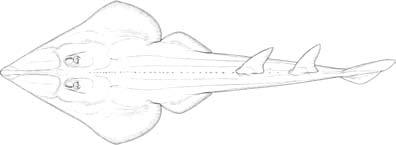

(Rhina ancylostoma)
Five paired gill slits on underside of head
Mouth on underside of head
Dorso-ventrally flattened body
Large first dorsal fin (set above pelvic fins in wedgefishes and well behind tips of pelvic fins in giant guitarfishes)
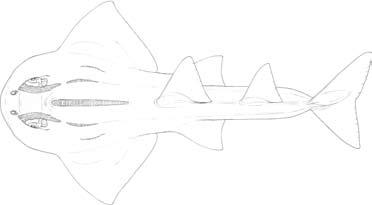
Second dorsal fin positioned further back Upper lobe of caudal fin longer than lower lobe
Pectoral fin attached to side of head
(Glaucostegus cemiculus)
Despite their ability to hide beneath the sand to avoid detection from potential predators and prey, angel sharks have not been able to escape the intensification of demersal fisheries. The slow growth and demersal nature of angel sharks means they are highly susceptible to fishing activities and they can easily become entangled in towed trawl gear and large-mesh gillnets. Although they are not necessarily directly targeted, bycatch is often utilised.
As a result of population declines, Squatinidae has been identified as one of the most threatened families of chondrichthyans (sharks, skates, rays, and chimaeras) in the world, with many species requiring urgent conservation action (Dulvy et al., 2014; Dulvy et al., 2021). Of the 23 described species, 13 are now listed in a threat category on the IUCN Red List of Threatened Species (eight Critically Endangered, four Endangered, and one Vulnerable), while one species remains Data Deficient and one recently discovered species is Not Evaluated.
Given the drastic declines of Squatina spp. in regions where they have been intensively fished, it’s clear that the family is unable to sustain intense fishing pressure. As such, catches (including of those species classified as Least Concern) should be carefully monitored to understand population trends and inform management. For those species already facing declines, a suite of measures should be considered, including species protection, spatial management, and bycatch mitigation.
NE
DD
Not Evaluated: not yet evaluated against IUCN Red List criteria.
Data Deficient: inadequate information exists to make an assessment.
Least Concern: low risk of extinction.
NT
Near Threatened: close to qualifying for a threatened category in the near future.
Vulnerable: high risk of extinction in the wild.
EN
cR
Endangered: very high risk of extinction in the wild.
Critically Endangered: extremely high risk of extinction in the wild
In many regions of the world angel sharks are still caught and retained. They are sold mainly for their meat, but also for their fins, eggs, and liver oil – as well as being utilised as fishmeal.
Despite all three Mediterranean species having a prohibition banning retention, they are still observed for sale in many fish markets (Gordon et al., 2019). In Libya, shark meat (including angel shark) is marketed as ‘sea dog’ without further clarification of species, and the eggs are sold as a treatment for urinary incontinence in children (pers comms.
Sara A. Al Mabruk).In South America, angel shark meat is sold fresh or salted and dried for local consumption. Despite being officially protected in Brazil, angel shark meat is marketed as ‘cacao anjo’ and it typically sells for a higher price than other shark meat. In Argentina, angel sharks are retained as bycatch and sold locally for the meat to either be consumed fresh as ‘pollo de mar’ (chicken of the sea) or salted and dried as ‘bacalao argentino’ (Argentine cod) (Chiaramonte, 1998).
Off the coast of Senegal, the fins of the Smoothback Angelshark (Squatina oculata) were prepared under the name of ‘laâf’ and exported (Capapé et al., 2002), while the liver oil was extracted and used to protect fermented dried fishes from infestation by insects.
Angelshark (Squatina squatina) meat in Libyan market
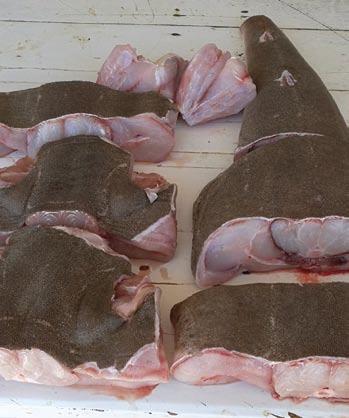 © Sara A Al Mabruk
© Sara A Al Mabruk














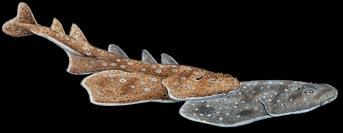








Distribution: Southeast Pacific from Columbia to the Strait of Magellan, southern Chile.
May overlap with Squatina californica in the northern parts of its range.
Fisheries: Taken as retained bycatch in trawl and gillnet fisheries. The fisheries within its range have generally been increasing in effort, yet catches have declined. Meat is used locally for human consumption, and in Peru the eggs are also valued.
♂
Dorsal surface is reddish-brown to grey in colour
Narrow head
Heavy thorns on snout and between eyes and spiracles
Enlarged thorns on the leading edge of the pectoral fins
Pelvic fin tips do not reach origin of first dorsal fin base

Narrow and simple barbels with anterior nasal flaps fringed
Double row of large, hooked thorns on midline of back extending beyond dorsal fins to the tail
Depth Max. length FAO
DMZ150cm30-75m
cR

Distribution: Northeast Pacific from Alaska to Baja California, Mexico (including Gulf of California). Possibly also occurs in the Southeast Pacific where it would be sympatric with Squatina armata, however there is some confusion with species in the region.
Fisheries: Through a ban on gillnet fisheries targeting California Halibut, fishing of Squatina californica is indirectly regulated and minimum retention size limits are in place. In Mexico, some fisheries must record angel shark catches in logbooks, and there are seasonal fishing closures for fisheries targeting elasmobranchs.
Concave between large eyes
Reddish-brown to sandy brown in colour
Scattered spots (set around dark spots in adults)
Large paired dark blotches on back and tail form large ocelli
Dark blotches at base of dorsal fins
Simple, conical nasal barbels with spatulate tips
Weakly fringed anterior nasal flaps

Spotted tail with dark blotch at base
Max. length FAO
White edged pectoral and pelvic fins
Distribution: Southwest Atlantic from Santa Catarina, Brazil to Buenos Aires, Argentina.
Fisheries: Formerly common but taken as target and bycatch species along with S. guggenheim and S. occulta in demersal trawl, gillnet, and longline fisheries – despite protective measures. Angel shark landings are typically aggregated.
Purplish-brown in colour (or dark-brown to reddish-brown)
Many scattered dark brown spots, mostly in a circular group around a central spot
No triangular lobes on lateral head folds
Concave between the eyes Enlarged thorns on snout

X No mid-dorsal line of thorns or enlarged dermal denticles
X Squatina
argentina lacks thorns between spiracles (a pair of thorns is present in other Western Atlantic angel sharks).
Large angular pectoral fins which are twice as long as they are wide
Paler dorsal fins

Simple, spatulate nasal barbels
Slightly fringed or smooth anterior nasal flaps
Depth Max. length FAO

Distribution: Southern Caribbean from Panama to Suriname and possibly to northwest Brazil.
Fisheries: Likely taken as bycatch in small-scale artisanal and commercial fisheries – including gillnets, trawls, and longlines.
(Acero et al., 2016; Vaz & de Carvalho, 2018)
Distance between eye and spiracle is 1.5x larger than eye diameter in specimens >60 cm TL
Males have dark spots; females have abundant whitish spots
X No mid-dorsal line of thorns or enlarged dermal denticles
♂
Pelvic fin tips do not reach origin of first dorsal fin base

Inner barbel has no fringe Outer barbel is divided
Nasal flap is a rounded triangle pointing downward, without fringes or serrations
Up until 2016, angel sharks caught in the southern Caribbean were thought to be S. dumeril until S. david was formally described.
Grey-brownish yellow in colour
Mature males have narrow patches of denticles on anterior edges of pectoral and pelvic fins (poorly developed in females)
Depth Max. length FAO NT
Unknown Largest described is 79cm 100-326m
ASK

Distribution: Western Atlantic, from Massachusetts to Florida, Gulf of Mexico and Mexican Caribbean
Fisheries: Protected throughout US waters so there is no directed fishery, however, is still caught as accidental bycatch in trawl fisheries.
NB: Two additional nominal species (S. heteroptera and S. mexicana) have previously been described from the western Gulf of Mexico, however with lack of distinguishing morphological characteristics and DNA studies, there is still some confusion as to whether they are valid species and so they are often regarded as synonyms of S. dumeril.
Blue-grey to ash-grey in colour with reddish hue to head and fin margins
♀
Dark spots can be irregularly present, but can be absent
Strongly concave between the eyes
A few small discrete thorns are present on the snout and between the eyes
Simple, tapering nasal barbels
Weakly fringed or smooth anterior nasal flaps
X No elaborate markings or ocelli
Eye-spiracle space
<1.5 times eye diameter
Pectoral fins are broad and posteriorly angular

Juveniles may have small white spots, along with thorns along the back from head to the dorsal fins (inconspicuous in adults).
SUD152cm0-1290m
Depth Max. length FAO Lc
Distribution: Southwest Atlantic from Rio de Janeiro, Brazil to northern Patagonia, Argentina.
Fisheries: Angel sharks are heavily fished in this region and significant declines have been documented. Taken as target and bycatch species in demersal trawl, gillnet, and longline fisheries, with landings typically aggregated.
NB: Mucous on dorsal surface has blackish pigments that appears to form darker rounded spots over whiter blotches. The dark spots shown on this illustration show the colour of the mucous on the skin – representing how they appear before this layer is washed away.
Small, rounded spots surround some larger blotches, forming irregular rosettes
Spots of variable size, with larger blotches on pectoral and pelvic fins

Dark tan in colour
♀
Short thorns in symmetrical groups on snout, between eyes, and between spiracles
Row of midline thorns from mid-length of pectoral fin base to the first dorsal fin (sometimes to caudal fin)
Pelvic fin tips do not reach origin of first dorsal fin base
S. punctata is a junior synonym of S. guggenheim
• Broadly concave between the eyes
• Anterior nasal flaps weakly fringed

• Unfringed nasal barbels
• Lateral folds without triangular lobes
Depth Max. length FAO
130m10-80m
EN

Distribution: Known only from the type location off the Caribbean coast of Panama.
Range overlaps with S. david by at least 500 km.
Fisheries: Unknown but may have depth refuge.
(Long et al., 2021)
Small scattered dark spots in males (larger along edge of head, outer half of pectorals & base of pelvic fins)
Colour light brown to tan (prior to preservation)
♀
A few large denticles on top of the head
Moderately angular pectoral fins, with anterior margin mostly straight and posterior margin slightly concave
Single dorsal midline row of slightly enlarged denticles
Species currently known only by two juvenile specimens smaller than 40cm TL.
Pelvic fin tips do not reach origin of first dorsal fin base
Pelvic fins broadly triangular
Edges of pectoral & pelvic fins fade into a lighter brown with a whitish margin
• Narrow mouth
• Distinct nasal flaps protruding from dermal folds above mouth. Nasal flap squared with a fine fringe on ventral edge
• Inner and outer nasal barbels short, flattened and rounded with a fine fringed margin
• Upper-lip arch semi-circular and broader than high
Depth Max. length FAO
Holotype caught at 1190m -1259m
Immature male (holotype) 40cm
ASK
NE
Distribution: Southwest Atlantic from southern Brazil (Rio de Janeiro) to Argentina (Buenos Aires Province – possibly further south to northern Patagonia).
Fisheries: Angel sharks are heavily fished in this region and significant declines have been documented. Despite protections in Brazil, enforcement regulations are not sufficient, and they are still caught illegally. In Argentina and Uruguay, there is a TAC for angel sharks.
2-3 enlarged denticles anterior and a pair posterior to each eye; and a pair between spiracles

Some larger white spots are surrounded by many black dots, forming irregular ocellilike markings
Numerous small white to yellowish spots and larger blackish marks
Head concave between eyes
Uniform dark tan in colour
Two rows of 3-4 enlarged denticles between nostrils
Three pairs of large blackish blotches, (adjacent to pelvic fin tip, first dorsal fin, and second dorsal) may be present

High and angular pectoral fins with leading edge straight and posterior edge concave
Anterior nasal flaps are very large with well developed barbels
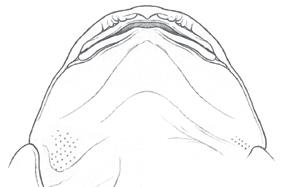
Nasal barbels have cylindrical bases with unfringed tips
Distribution: Southwest Atlantic in eastern Brazil from northern Rio de Janeiro State to Sergipe State.
Fisheries: This species likely has depth refuge as no deepwater fisheries currently operate within its range.
(Vaz & de Carvalho, 2018)
♂
Very few (<20) rounded white spots on trunk and pectoral fins, sometimes absent
Pair of enlarged dermal denticles between spiracles
Dark to light brown in colour
A semi-elliptical lobe projects from the lateral dermal fold of the head (its presence distinguishing S. varii from other Southwest Atlantic angel sharks)
Pectoral-fin spots consistently arranged with one close to the pectoral origin, one on the medial region, and a pair of spots horizontally aligned on the posterior third of the pectoral fin length

Dark spots on dorsal of some specimens – no symmetrical pattern
Pelvic fin tips do not reach origin of first dorsal fin base
Three pairs of dark blotches on tail (on origin, first dorsal-fin base, and second dorsal-fin base)
ASK♀ 132cm 195m -666m
Depth Max. length FAO Lc

Distribution: Eastern Atlantic from Senegal to Sierra Leone, and the Mediterranean Sea.
Despite prohibitions on retention in the Mediterranean,
species is still caught and retained as bycatch.
et al.,
Gordon et al.,
One row of dorsal spines
from other species in the region)
Light grey/brown mottled
darker brown
Large dark blotches on dorsal surface and tail may be present
Concave between eyes
Large thorns on head (spines on the snout and above the eyes)
fin tips extend
origin of
dorsal fin

Irregular small, white spots and regular small, dark brown spots
Heavily fringed nasal barbels and anterior nasal flaps
FAO
Distribution: Eastern Atlantic from Senegal to Ghana, and the Mediterranean Sea (predominantly the central and eastern basins).
Fisheries: Despite prohibitions on retention in the Mediterranean, this species is still caught and retained as bycatch.
et al., 2019; Gordon et al., 2019)
Small white and dark spots
Sometimes symmetrical brown ocelli surrounded by white spots on pectoral fins, tail, and body

Smallest of the three Mediterranean species
Thorns present above the eyes and around the snout
Grey-brown
♀
Dorsal and caudal fin margins are white
Pelvic fin tips do not reach origin of first dorsal fin base

Large dark blotches on base and rear tips of pectoral fins, tail base, and under dorsal fins
Anterior nasal flaps weakly fringed
Strongly concave between eyes
Weakly bifurcate or lobed nasal barbels
Depth Max. length FAO
20m -560m
160cm
145cm
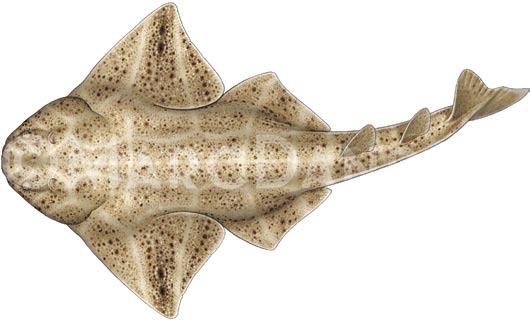
Distribution: Northeast Atlantic (Celtic Seas ecoregion), Canary Islands and Mediterranean Sea.
Fisheries: Intensification of demersal fishing practices over the past century led to widespread declines and fragmented populations – this species now receives full protection in the UK and Canary Islands. Prohibitions on retention are in place in the Mediterranean, however it is still widely caught and retained as bycatch.
et al., 2019; Gordon et al., 2019)
Reddish or greenish-brown
small white spots and dark dots
nasal barbels
Lateral head folds with singular triangular lobe each side

Small patches of thorns on the snout and between the eyes
Concave between the eyes
or weakly fringed anterior nasal flaps
Max. length FAO
Broad pectoral fins
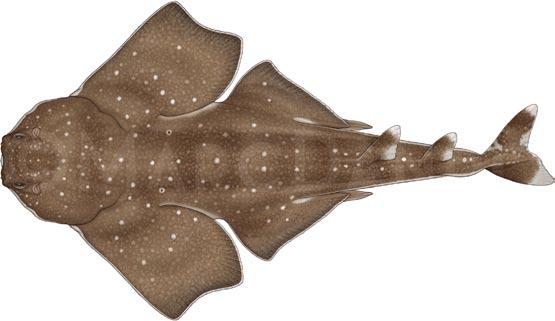
Distribution: East and southern Africa from Somalia to South Africa, and Madagascar.
Fisheries: Caught in large-scale and small-scale fisheries, many of which are unregulated. The population around KwaZulu-Natal, South Africa appears stable, however suspected declines are anticipated throughout the remainder of its range.
Grey-reddish brown in colour
Young often have large granular centred ocelli
♂
Numerous light and dark spots
Simple, flat nasal barbels with tapering or spatulate tips

Concave between eyes Enlarged thorns on head
No angular lobes on lateral dermal flaps
Darker saddles across bases of dorsal fins
White blotches on tip and base of dorsal fins and tips of caudal lobes
Anterior nasal flaps smooth or slightly fringed
Depth Max. length FAO NT
SUF122cm494m
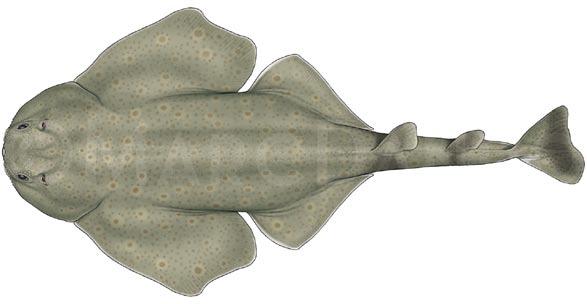
Distribution: Western Central Pacific – only known from type specimen caught southeast of Luzon, Philippines.
Fisheries: Unknown – deepwater fisheries (including deep-set hook and line) operate in the Philippines.

(Walsh et al. 2011)
Greenish brown in colour
Numerous dark brown spots outlined in white margins
♀
Following preservation, colour fades to deep brown with white spots, and subdorsal saddles/ white margins on pelvic fins no longer visible.
Eyes almond-shaped and close-set
Pelvic fin tips extend to origin of first dorsal fin
Black subdorsal saddles
Upper lip arch semi-oval in shape
Simple, unfringed nasal barbels, with rod-like tips
White margins on pelvic fins
Inter-dorsal space greater than dorsalcaudal space (separating species from S. formosa and S. nebulosa)
Depth Max. length FAO
ASKUnknown Unknown Holotype caught 363-385m
DD
Distribution: Northwest Pacific, endemic to Taiwan.
Fisheries: Subject to fishing pressure across its range. Taken as retained bycatch, in particularly large numbers in demersal trawl fisheries. Retained for meat and fins (which are of low value), with smaller individuals used for fish meal.
Light to dark brown with numerous dark and light spots of varying sizes
♀
Eye-spiracle space less than eye length
Small pairs of dark ocelli
Many small light and dark spots, with larger irregular blotches
Patches of enlarged denticles on snout, between eyes
Head concave between large eyes
Saddle or dark band across base of dorsal fins Lobed caudal fin


Weakly fringed or smooth anterior nasal flaps, no triangular lobes on lateral head folds
Simple, flat nasal barbels, tapering around tips
Upper lip arch semi-circular (height greater than in other Squatinids in the region )
Pelvic fin tips extend to origin of first dorsal fin
Pectoral fins broadly rounded, especially posterior free tip
Colour after preservation fades to a lighterbrown with spots becoming more indistinct.
Depth Max. length FAO EN
SUO150cm100m -400m

Distribution: Northwest Pacific from southern Russia to southern Taiwan, including Japan, North Korea, South Korea, and China.
Fisheries: Taken as retained bycatch in fisheries operating down to 300m. Fishing pressure is high across the entire spatial and depth range of this species, providing little refuge.
(Walsh & Ebert, 2007)
Dense dark and small irregular white spots on dorsal surface
Rusty brown in colour with distinct freckled pattern
♀
Small thorns on snout, between eyes and spiracles
Large paired dark redbrown spots from base of head to pelvic fins
Prominent row of midback thorns extending to the caudal peduncle (the only Squatinid in this region with midback thorns)
Wide but shallow upper lip arch
Concave between large eyes
Pelvic fin tips do not reach origin of first dorsal fin base (unique to S. japonica and S. tergocellatoides in this region)
Broad pectoral fins, rounded posteriorly
Weakly fringed or smooth nasal flaps
Cylindrical nasal barbels, with slightly expanded tips
Lateral head folds without triangular lobes

SUJ200cm10-352m
Depth Max. length FAO cR

Distribution: Central Indo-Pacific in southern Indonesia (West Java to Flores Island).
Fisheries: There is intensive fishing pressure across the entire range of this species in Indonesia. It has been reported to be caught incidentally on demersal longline fisheries, but is now only rarely landed.
Pale blotches
Uniformly greybrown
♂
Species known from just a few specimens.
Two dark, subdorsal saddles
• Short snout
• Head weakly concave between large eyes
Anterior nasal flap with unfringed barbels


• Upper lip arch half-oval in shape
First dorsal fin base longer than second
Pelvic fin tips extend to origin of first dorsal fin
ASK134cmUnknown
Depth Max. length FAO cR
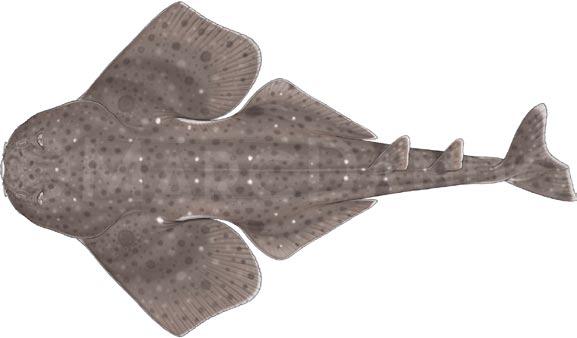
Distribution: Western North Pacific from Japan (including Ryukyu Islands), to Taiwan (including North Korea, South Korea, and China).
Fisheries: Retained bycatch in demersal fisheries (trawl, gillnet, set net, and longline) operating down to 600m.
(Walsh & Ebert, 2007)
Dark brown to blueish-brown
Large rounded dark spot at base of pectoral fin
Scattered light and dark spots of varying sizes
Upper lip arch
half-oval in shapeLateral head folds with two triangular lobes each side
Pelvic fin tips extend to origin of first dorsal fin
Angular pelvic, dorsal, and caudal fins

Weakly fringed or smooth anterior nasal flaps
Simple tapering nasal barbels
Light dorsal fin margins
Dark blotches at base of dorsal fins
Broad, posteriorly rounded pectoral fins
SUL200cm 0-330m possibly deeper
Depth Max. length FAO EN

Distribution: Northwest and Western Central Pacific in Taiwan and China (South China Sea), as well as Vietnam and Borneo.
Fisheries: Subject to fishing pressure across its entire range. Caught as bycatch in demersal fisheries and retained for meat and fins, with smaller individuals used for fish meal.
(Walsh & Ebert, 2007; Theiss & Ebert, 2013)
Dense scattering of small round white spots
Six pairs of large black spots on pectoral fins, pelvic fins, and tail base
Following preservation, colour fades and spots become almost indistinguishable.
Lateral head folds have two low rounded lobes on each side

Light yellowishbrown
Concave between the eyes
Strongly fringed anterior nasal flaps
Ornate, finely fringed nasal barbels
Black blotch at base of each dorsal fin
Pelvic fin tips do not reach origin of first dorsal fin base (unique to S. tergocellatoides and S. japonica in this region)
Caudal fin triangular in shape, with lower lobe longer than upper lobe (unique to Western North Pacific Squatinids)
Depth Max. length FAO EN
SUN150cm100m -300m

Distribution: East coast of Australia from Cairns (Queensland) to Lakes Entrance (Victoria). Between Newcastle (central New South Wales) and eastern Victoria, this species overlaps with S. australis
Fisheries: Has been heavily fished and remains a marketable bycatch in the southern part of its range. Captures are much rarer in the northern part of its range, where abundance is anticipated to be lower.
Yellow-brown to chocolate-brown in colour (though colouration and patternation are highly variable)
Spiracles close to eyes, wider than eye-length
Short snout
White nuchal spot
Large dark blotches
Dense pattern of symmetrical small, white, dark-edged spots
Heavy orbital thorns (distinguishing from Squatina australis) Concave interorbital space
Nasal barbels have expanded tips and lobate fringes

Depth Max. length FAO VU
130cm
110cm

Distribution: East and south of Australia from Newcastle (New South Wales) south and west to Rottnest Island, (Western Australia). Between Newcastle (central New South Wales) and eastern Victoria, this species overlaps with S. albipunctata.
Fisheries: Taken as retained bycatch in managed gillnet and trawl fisheries targeting higher valued species.
(Last & Stevens, 2009)
Dull greyishbrown in colour
♀
Small spiracles
X No large thorns in adults, young have enlarged denticles on snout, head, and multiple predorsal rows
Dense white spots with small darker brown spots (some individuals have more darker brown medium spots, often arranged in small rosettes with fewer paler spots, others have more whiter spots and so the individual appears paler in colour)
White-edged fins
Spots on leading edge of pale dorsal fins
Head flat or convex between eyes
Heavily fringed nasal barbels and anterior nasal flaps

No triangular lobes on lateral head folds
Numerous dark spots on lower lobe of caudal fin
Depth Max. length FAO Lc
0m -130m
SUU152cm
Distribution: Northwest Australia from Cape Leveque to Shark Bay (Western Australia).
Fisheries: Poorly known, but likely only minor bycatch as fishing effort is low within the species range. Its range also overlaps with some areas closed to trawling, offering additional refuge.
Pattern of widely spaced grey-blue spots and brown blotches
Medium to pale brown or grey

♂
Short snout
Single small white nuchal spot
Medial row of predorsal thorns
Strong orbital thorns
Head concave between eyes
Nasal barbels with expanded tips and lobate fringes
Light unpaired fins
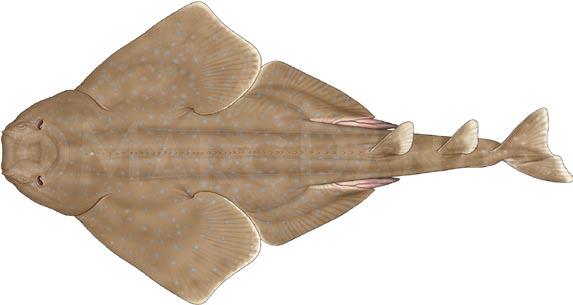
Depth Max. length FAO
ASK
Lc
-312 m
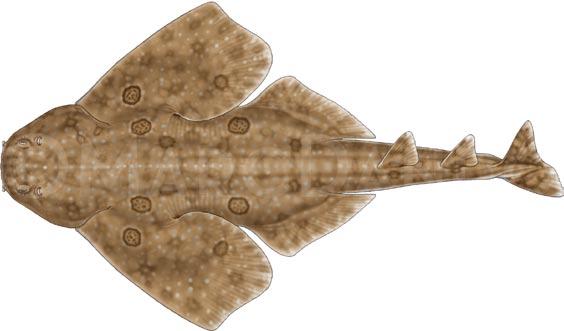
Distribution: Southwest Australia from Port Lincoln (South Australia) to Geraldton (Western Australia).
Fisheries: Commonly taken as bycatch in managed fisheries (Great Australian Bight Trawl Sector of the Southern and Eastern Scalefish and Shark Fishery).
(Last & Stevens, 2009)
Pale yellow-brown
Strongly concave between the eyes
Grey-blue or white spots
Strongly fringed nasal barbels and anterior nasal flaps

Fins pale with spots/blotches
Three pairs of large ocelli, dark rings around centres with amitotic pattern
Max. length FAO
140cm
SUE
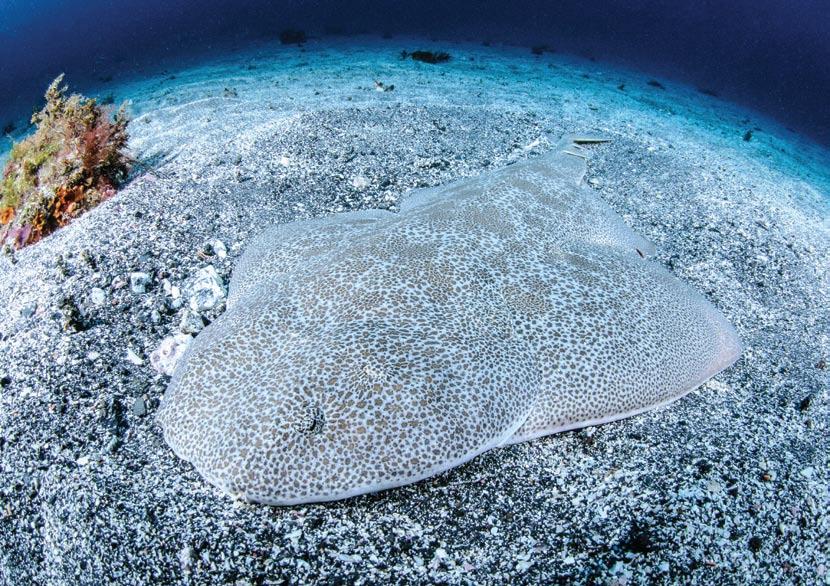
* where no individual code has been assigned, ASK is used for the family Squatinidae (‘Angelsharks, sand devils nei’)
Squatina aculeata Sawback Angelshark Cuvier, 1829
Squatina africana African Angelshark Regan, 1908
CR SUA Eastern Atlantic & Mediterranean
NT SUF
Squatina albipunctata Eastern Angelshark Last & White, 2008
Squatina argentina Argentine Angelshark (Marini, 1930)
Squatina armata Chilean Angelshark (Philippi, 1887)
Squatina australis Australian Angelshark Regan, 1906
Squatina caillieti Philippine (or Cailliet’s) Angelshark Walsh, Ebert & Compagno, 2011
Squatina californica Pacific Angelshark Ayres, 1859
Squatina david David’s Angelshark Acero P., Tavera, Anguila & Hernández, 2016
Squatina dumeril Atlantic Angelshark Lesueur, 1818
VU ASK
Western Indian Ocean (Kenya, Madagascar, Mozambique, Somalia, South Africa, Tanzania)
Australia (Queensland, New South Wales, Victoria)
Argentina, Brazil, Uruguay
CR SUG
CR DMZ Chile, Colombia, Ecuador, Peru
LC SUU
Australia (Victoria, Tasmania, South Australia, Western Australia, New South Wales)
Western Central Pacific (Philippines)
DD ASK
NT SUC Northeast Pacific (Canada, Mexico, USA)
NT ASK
Southern Caribbean (Panama –Suriname)
LC SUD
Squatina formosa Taiwan Angelshark Shen & Ting, 1972 EN SUO
Squatina guggenheim Angular Angelshark Marini, 1936
EN SWV
From southern New England to Florida and the Gulf of Mexico
Northwest Pacific (China, Taiwan)
Argentina, Brazil, Uruguay
* where no individual code has been assigned, ASK is used for the family Squatinidae (‘Angelsharks, sand devils nei’)
Squatina japonica Japanese Angelshark
Squatina legnota Indonesian Angelshark
Squatina mapama Small-crested Angelshark
Squatina nebulosa Clouded Angelshark
Squatina occulta Hidden Angelshark
Squatina oculata Smoothback Angelshark
Squatina pseudocellata Western Angelshark
Bleeker, 1858
CR SUJ
Last & White, 2008
CR ASK
Northwest Pacific (China, Japan, Korea, Taiwan)
Central Indo-Pacific (Southern Indonesia)
Long, Ebert, Tavera, Acero & Robertson, 2021
Regan, 1906
Vooren & da Silva, 1991
Bonaparte, 1840
Last & White, 2008
NE ASK
Caribbean coast of Panama
EN SUL
Northwest Pacific (Japan, China, Taiwan)
Argentina, Brazil, Uruguay
CR SZJ
CR SUT
Eastern Atlantic & Mediterranean
LC ASK
Squatina squatina Angelshark (Linnaeus, 1758)
Squatina tergocellata Ornate Angelshark McCulloch, 1914
Squatina tergocellatoides Ocellated Angelshark Chen, 1963
Squatina varii Vari’s Angelshark
Western Australia
CR AGN Northeast Atlantic & Mediterranean
LC SUE Australia (South Australia, Western Australia)
EN SUN
Northwest & Western Central Pacific (South China Sea)
Vaz & Carvalho, 2018 LC ASK Brazil
On the Pacific coast, management measures (including a ban on nearshore gillnets and minimum size limits) have significantly reduced landings of S. californica. With ground fisheries managed, the threat of targeted commercial fishing in the United States has ceased for this species, though they can still be caught as accidental bycatch in fisheries.
In Brazil, retention of angel sharks (S. argentina, S. guggenheim, and S. occulta) has been prohibited since 2004, following inclusion on the Brazilian Endangered Species List (Casselberry and Carlson, 2015). Squatina varii was described (Vaz and de Carvalho, 2018) after this and so is not formally included and no species-specific conservation measures are in place. Trawling in Brazilian inshore waters is prohibited, offering some refuge to these species. However, enforcement regulations are not sufficient as they are still caught in trawl and gillnet fisheries and retained to be sold in markets (Almerón-Souza et al., 2018).

In the Argentinian-Uruguayan Common Fishing Zone (AUCFZ), there is a TAC for angel sharks (S. argentina, S. guggenehim, S. occulta) along with a managed fishing area which has a seasonal closure (October – March) to all vessels using bottom net trawling.
There is also a Maximum Permitted Catch for angel sharks in Argentinian waters south of the AUCFZ, however this is often exceeded.
In Atlantic US waters, angel sharks are prohibited under the Federal Management Plan for Atlantic Tunas, Swordfish and Sharks as a precautionary management measure, and so they are typically discarded alive at sea.
S. david and S. mapama have no known conservation measures in place.
The Angelshark (S. squatina) has the most protective measures in place (Lawson et al., 2019). As well as being designated a Prohibited species for EU and UK commercial vessels, it is included in Appendix I and II of the Convention on the Conservation of Migratory Species of Wild Animals (CMS) and Annex I of the CMS Memorandum of Understanding on the Conservation of Migratory Sharks (CMS Sharks MOU). In addition, it is listed on domestic wildlife protection orders in the UK and Canary Islands. This species, along with Squatina aculeata and S. oculata, is also listed on Annex II of the Barcelona Convention, under the General Fisheries Commission for the Mediterranean (GFCM) binding Recommendation, and all three receive domestic protection in multiple Mediterranean countries (Lawson et al., 2019; Gordon et al., 2019).
While no species-specific measures are in place, the habitat of Squatina africana falls within extensive Marine Protected Areas (MPAs) on the east coast of South Africa, which are closed to fishing and generally well policed.
There are no species-specific conservation measures in place for any of the six species encountered in the Northwest Pacific. A number of regions (e.g. Japan, China, Taiwan) have some fisheries management measures in place to control fishing effort (including demersal trawling bans), which will provide some refuge for angel sharks.
No species-specific measures are in place; however, some areas are closed to trawling which offers refuge for demersal species such as angel sharks. Three of the species encountered in Australian waters are listed as Least Concern and are all taken as bycatch in managed fisheries. In contrast, S. albipunctata has been heavily overfished and is subsequently considered Vulnerable, despite this, there are no conservation measures in place and bycatch is marketed.

The Angel Shark Conservation Network (ASCN) represents a community working to better protect angel sharks. The Network was collaboratively founded by the Angel Shark Project, International Union for the Conservation of Nature (IUCN) Species Survival Commission Shark Specialist Group, Shark Trust, Submon, Universidad de Las Palmas de Gran Canaria (ULPGC), Zoological Research Museum Alexander Koenig (ZMFK) and the Zoological Society of London (ZSL). The ASCN was established to facilitate dialogue and information sharing on angel shark conservation efforts, in particular across the range of the three species found in the Eastern Atlantic and Mediterranean Sea. However, collaborators are welcomed from all regions so if you’re interested in finding out more, and to record any angel shark sightings, visit www.angelsharknetwork.com.

ASCN partners have coordinated the development of several strategic conservation planning documents, with input from multiple stakeholders. These include the Eastern Atlantic and Mediterranean Angel Shark Conservation Strategy which provides a broad framework for protection for S. aculeata, S. oculata, and S. squatina; the Angelshark Action Plan for the Canary Islands (S. squatina); the Wales Angelshark Action Plan (S. squatina); the Mediterranean Angel Sharks: Regional Action Plan (S. aculeata, S. oculata, S. squatina); along with SubRegional Action Plans for a number of Mediterranean regions (including Aegean Sea/ Crete, Cyprus, Libya and Turkey).
The Angel Shark Project are collecting genetic samples to understand how populations are connected across their range. If you have samples or data you would like to contribute, get in touch with them at info@angelsharkproject.com.
The inaugural International Angel Shark Day was held in 2020, and is now celebrated annually on 26 June. #AngelSharkDay
This guidance has been developed with fishers to reduce mortality if angel sharks are accidentally caught in regions where prohibitions are in place.
Check the national regulations in your region to find out
if there are any species-specific conservation measures in place that prohibit retention of angel sharks.
Record the size and sex of the shark. Male sharks have two claspers (long appendages) behind the pelvic fin.
This helps us to understand population structure.
Unhook the angel shark in the water on the side of the boat. If you have to cut the leader, cut it as close to the hook as possible.
Water supports the internal organs.
Release the shark as soon as possible after unhooking. Lower it into the water facing the tide or waves. Forces oxygen through its gills so that it can quickly swim away.
If there are, follow these best-practice guidelines to safely release any individuals caught.
Report your capture using your national recording procedure (by FAO code if confident of species ID) and to the Angel Shark Sightings Map at angelsharknetwork.com/#map.
Always use barbless non-stainless circle hooks (or a circle hook with the barb flattened down).
This reduces the chance of gut-hooking so that it is easier to unhook the shark.
Use a strong line.
This reduces the likelihood of the line snapping and the shark trailing gear.
Never hold the shark just by its tail, its fins or by the gills; you need to support the underside of the shark.
Support the internal organs to reduce a chance of injury.
3. Reporting
Report your accidental capture on angelsharknetwork.com/#map
We will use this information to better understand and conserve angel sharks.
Landing aboard the boat (ONLY if necessary)
All interaction with sharks should be minimised. If you need to land aboard the boat to unhook safely, use a large landing net. Never use a gaff.
Support the internal organs to reduce a chance of injury.
Place it on a cool, wet, soft surface (e.g. a wet towel).
Place a towel soaked in seawater over the eyes.
To keep it calm and stop it thrashing.
It is hoped that this guide will help expose more images of angel sharks in different regions, along with more speciesspecific information to help better understand angel sharks around the world. We would welcome additional content as it becomes available so that we may improve upon the information provided here, email angels@sharktrust.org.

Images of live angel sharks are scarce for many species, and so we are especially thankful to those who donated photos for use both within this guide and as reference material to aid the creation of species illustrations - this includes Andy Murch, Nathan Bass, Vincent Raoult, and Francisco Concha. All illustrations were created by Marc Dando for which we are grateful, and the guide was designed by Rob Bowker who we thank for his patience!
Thank you to those who have reviewed draft content and offered comments, including Dave Ebert, Will White, Diego Vaz, Francisco Concha, and of course Marc Dando.
The development of this identification guide was made possible through the generosity of the Disney Conservation Fund, for this we extend our gratitude. Our thanks are also extended to the Shark Conservation Fund for progressing work on angel sharks.

Acero, A.P., Tavera, J.J., Anguila, R. and Hernández, L. 2016. A New Southern Caribbean Species of Angel Shark (Chondrichthyes, Squaliformes, Squatinidae), Including Phylogeny and Tempo of Diversification of American Species. Copeia 104, No. 2, 577–585.
Almerón-Souza, F., Sperb, C., Castilho, C.L., Figueiredo, P.I., Gonçalves, L.T., Machado, R., Oliveira, L.R., Valiati, V.H. and Fagundes, N.J. 2018. Molecular identification of shark meat from local markets in Southern Brazil based on DNA barcoding: Evidence for mislabeling and trade of Endangered species. Frontiers in Genetics; 9.
Capapé, C., Seck, A.A., Gueye-Ndiaye, A., Diatta, Y. and Diop, M. 2002. Reproductive biology of the smoothback angel shark, Squatina oculata (Elasmobranchii, Squatinidae), from the coast of Senegal (eastern tropical Atlantic). Journal of the Marine Biological Association UK; 82: 635640.
Casselberry, G.A. and Carlson, J.K. 2015. Endangered Species Act Status Review of the spiny angel shark (Squatina guggenheim). Report to the National Marine Fisheries Service, Office of Protected Resources. SFD Contribution PCB-15-10. Chiaramonte, G.E. 1998. Shark fisheries in Argentina. Marine and Freshwater Research; 49(7): 601-609.
Dulvy, N.K., Fowler, S. L., Musick, J.A., Cavanagh, R.D., Kyne, P.M., Harrison, L.R., Carlson, J.K., et al. 2014. Extinction risk and conservation of the world’s sharks and rays. eLife, 3: e00590.
Dulvy, N.K., Pacoureau, N., Rigby, C.L., Pollom, R.A., Jabado, R.W., Ebert, D.A., Finucci, B., et al. 2021. Overfishing drives over one-third of all sharks and rays toward a global extinction crisis. Current Biology 31 (22), 5118–5119.
Ebert D.A., Dando, M. and Fowler, S. 2021.
Sharks of the World: A Complete Guide. Wild Nature Press.
Gordon, C.A., Hood, A.R., Al Mabruk, S. A. A., Barker, J., Bartolí, A., Ben Abdelhamid, S., Bradai, M.N., Dulvy, N.K., Fortibuoni, T., Giovos, I., Jimenez Alvarado, D., Meyers, E.K.M., Morey, G., Niedermuller, S., Pauly, A., Serena, F. and Vacchi, M. 2019. Mediterranean Angel Sharks: Regional Action Plan. The Shark Trust, UK.
Jabado R.W. 2019. Wedgefishes and Giant Guitarfishes: A Guide to Species Identification. Wildlife Conservation. Society, New York, United States.
Last, P.R. and Stevens, J.D. 2009. Sharks and Rays of Australia. Second Edition. CSIRO Publishing, Collingwood.
Lawson, J.M. Pollom, R., Gordon, C.A., Barker, J., Meyers, E.K.M., Zidowitz, H., Ellis, J.R., Bartolí, A., Morey, G., Fowler, S.L., Jiménez Alvarado, D., Fordham, S., Sharp, R., Hood, A.R., & Dulvy, N.K. 2019. Extinction risk and conservation of Critically Endangered angel sharks in the Eastern Atlantic and Mediterranean Sea. ICES Journal of Marine Science; 77:12–29.
Long, D.J., Ebert, D.A., Tavera, J., Acero, A., Robertson, D.R., 2021. Squatina mapama n. sp., a new cryptic species of angel shark (Elasmobranchii: Squatinidae) from the southwestern Caribbean Sea. Journal of the Ocean Science Foundation; 38.
Theiss, S.M. and Ebert, D.A. 2013. Lost and found: recovery of the holotype of the ocellated angelshark, Squatina tergocellatoides Chen, 1963 (Squatinidae), with comments on western Pacific squatinids. Zootaxa 3752 (1): 073–085
Vaz, D.F.B. and de Carvalho, M.R. 2018. New Species of Squatina (Squatiniformes: Squatinidae) from Brazil, with Comments on the Taxonomy of Angel Sharks from the Central and Northwestern Atlantic. Copeia 106, 144–160.
Walsh, J.H., and Ebert, D.A. 2007. A review of the systematics of western North Pacific angel sharks, genus Squatina, with redescriptions of Squatina formosa, S. japonica, and S. nebulosa (Chondrichthyes: Squatiniformes, Squatinidae). Zootaxa 1551: 31-47.
Walsh, J.H., Ebert, D.A. and Compagno, L.J.V. 2011. Squatina caillieti sp. nov., a new species of angel shark (Chondrichthyes: Squatiniformes: Squatinidae) from the Philippine Islands. Zootaxa 2759: 49–59.
 Australian Angelshark (Squatina australis) © Nathan Bass
Australian Angelshark (Squatina australis) © Nathan Bass
Squatina spp. have declined dramatically in many regions, it’s clear that this family is unable to sustain intense fishing pressure. Catches should be carefully monitored to understand population trends and better inform management and conservation measures.
